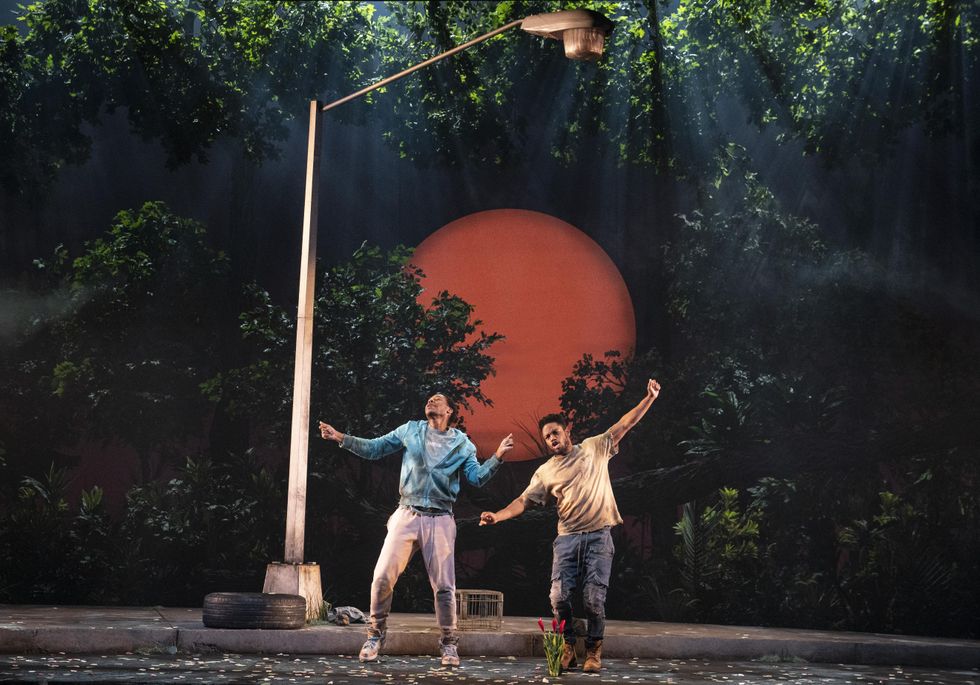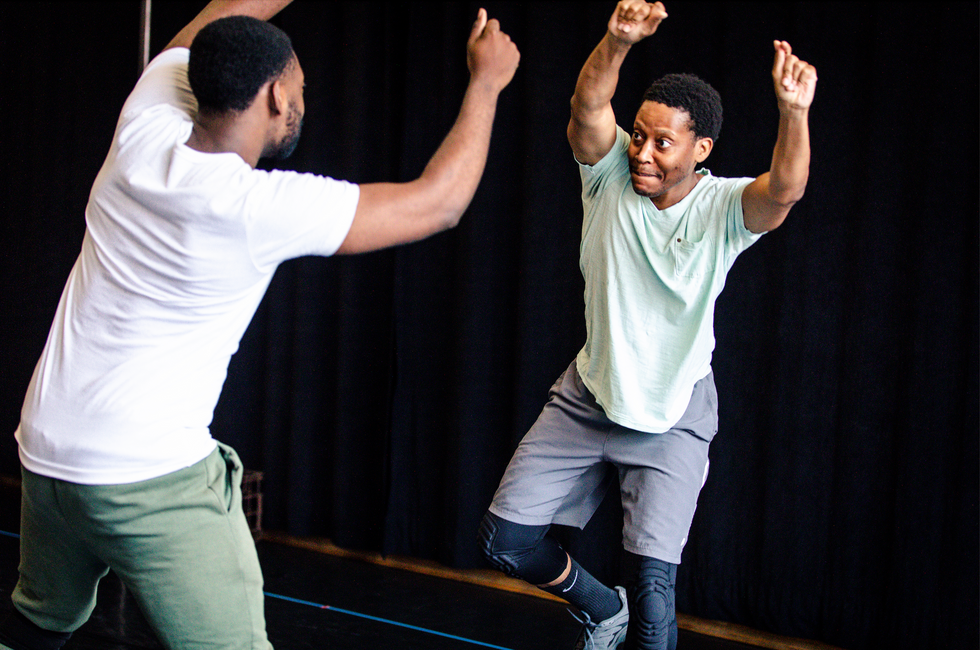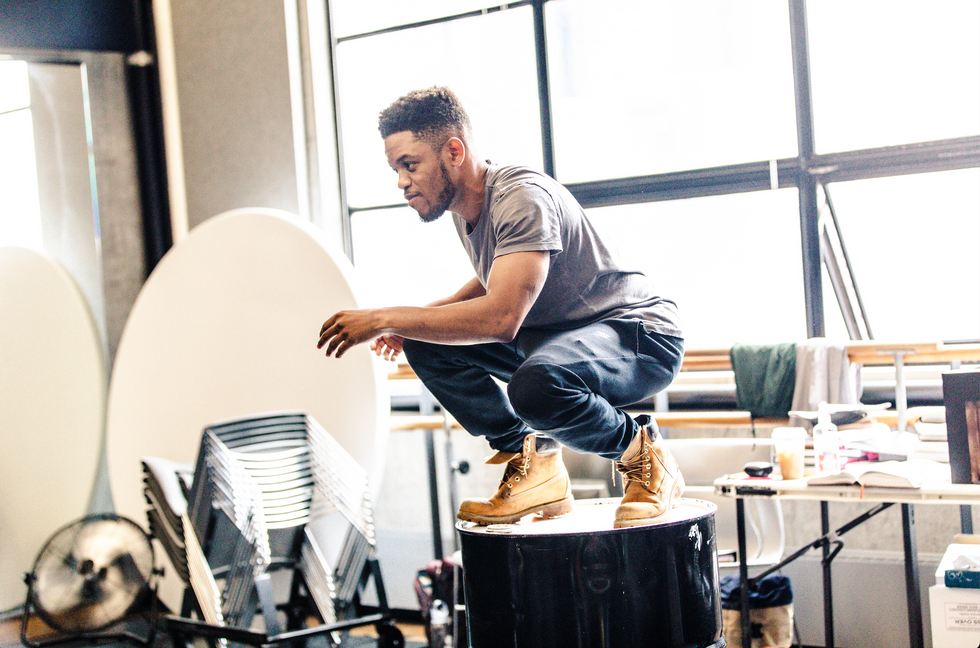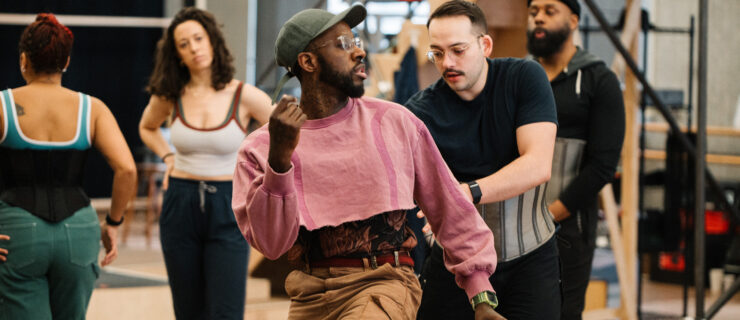Don’t Call It Choreography: Inside the Propulsive, Powerful Movement of Broadway’s First Post-Pandemic Play
At the beginning of Pass Over, the play’s charismatic protagonist, Moses, played by Jon Michael Hill, wakes up and flips his hat onto his head.
It’s a small gesture, but like all the movement in the show, it says a lot. “It’s a moment of such confidence and prowess,” says director Danya Taymor. “It lets the audience know, ‘You’re good. I got you. I’m the leader and I’m telling this story. So you can keep your eyes on me if you want to know what’s going on.'”
Equally in conversation with the Book of Exodus and Samuel Beckett’s Waiting for Godot, Pass Over, the first play on Broadway post-pandemic, reimagines Beckett’s “tramps,” Vladimir and Estragon, as young Black men (Moses and Kitch) living in a police state. And it does so with an economical, poetic script by Antoinette Chinonye Nwandu, and with movement that’s tempting to call dance but is certainly not choreography, according to Taymor.
“There’s not even blocking,” she says. “I mean, there’s a little blocking.” The movement, which is partially improvised and changes from night to night, was created by Taymor and the actors, Hill, Namir Smallwood and Gabriel Ebert, and a special guest—clown and Beckett expert Bill Irwin, who served as movement consultant.
“It was like kismet—Bill had to work on this,” says Taymor. “And so we tracked him down and didn’t let him say no.”
Dance Magazine spoke to Taymor and Irwin about how they developed Pass Over‘s striking non-choreography.

Danya, you’ve been with Pass Over since 2017. Bill, how long have you been with the project?
Bill Irwin: Hardly at all. It gives me an opportunity to just go on record as saying that this quite astounding piece of work on that Broadway stage has zero to do with this physical artist.
Danya Taymor: That’s not true. What’s cool about what Bill did was he gave us a few really direct links to different ways of moving, different embodiments, different traditions. He let us all be tramps, and we’d been investigating that. But to get to work with Bill just opened up different doors that we have been knocking at and Bill was like, Let me just open this for you.
How did the movement in the show evolve into what it looks like today?
DT: A lot of the movement in my work comes from mirroring, which is like the most basic of all theater exercises. But it allows connection between performers—they really have to gaze into each other’s eyes, and there’s nothing more intimate than that. I also like to do these weird partner stretches. So it creates a trust and dependence on your fellow ensemble members. Antoinette and I have also talked about different comedic duos through time, like Abbott and Costello, Nichols and May, Laurel and Hardy, Key and Peele. Obviously, Vladimir and Estragon. So many of these duos are working with great physicality. We wanted to find ways to bring joy into all the bodies onstage and freedom and looseness and goofiness. These young men should be allowed to be just silly. Especially considering what their day-to-day is.

Can you talk about how the idea of “trampness” translates into movement in Pass Over?
BI: Here’s a stage direction from Mr. Beckett’s play: “They stand motionless, arms dangling, head sunk, sagging at the knees.” I mean, he is that particular.
DT: Bill came in one rehearsal and literally just brought them big shoes and big pants with suspenders. So they could just feel their bodies in those clothes. Something else we experimented with on a day when Bill was in was the exploration of the feminine body. So often in Pass Over the way the characters can be intimate with one another is when they embody women. I had a friend come and she was like, I just think women are going to flock to this play to see men given permission to be so vulnerable and so free, because society doesn’t like to let them do that.
BI: And it’s happening on a truly movement dimension. Actors are told all the time, “Be vulnerable here. So as you’re reading text, you’re looking for ways to find that. But finding it in the standing body is a different craft.
What is the role of movement in the show?
BI: I think it is inextricable. And that is part of the joy of watching this work. It is a weave that is very hard to disentangle.
DT: When they think of movement, people think about choreography or something set, or something that somebody decided upon and then taught. And as a director, that’s never how I go about it. I will let the actors do the play on its feet for, like, 10 days before I come in and even give a suggestion, because I’m hoping that if you have performers that are strong enough, as these three men are, they’re gonna figure it out. It’s always better if it comes from inside them. That’s why it feels so alive and so precise. I’ve given them full permission: If they can’t get there, do what’s real. Part of why it’s so striking is because of the trust they have with themselves and with each other.
How much are they actually experimenting with the movement each night?
DT: I’d say 25 percent of it is different every night. The three actors before every show huddle up, and they say, “What shall we play tonight, gentlemen?,” and they suggest a different musician. It could be a musician, it could be a genre, it could be a song, it could be an album. And then after half an hour, they go and they all listen to that music. And then that’s the show they do. And so there are certain sections of movement where the line of it is known, but how you get from A to B, as long as you can honestly go from A to B, get there however you want. That keeps it alive, especially in a long run. It keeps it really playful for them. It’s the same story being told every night, but it’s a different show.
Moses and Kitch move through space in such a specific way. How did you develop that shared movement language?
DT: A lot of the Moses and Kitch stuff really is just mirroring. And they’re letting their different bodies inform that mirror. So it’s not like Moses and Kitch are the same and they’re doing the same movement. Moses will mock Kitch and filter it through his body. It gives this permission for repetition, which I feel like is a really Beckettian thing, and really part of Moses and Kitch’s everyday. They play these games; they recycle them. Kitch especially gets real comfort in the routine of it.
Do you each have a favorite movement moment from the show?
BI: At the very end, when Moses takes his clothes off, it is a glorious moment of theater.
DT: Yeah, the disrobing is exciting. I like when they take off their microphones. I like that final acknowledgment that, yes, we’ve all been in this room together. And we still are in this room together. And that acknowledgment through movement is singular to theater to be able to say, “Yeah, we’ve been breathing the same air this whole time and we’re not asking you to pretend otherwise. That happened. That all happened.”




